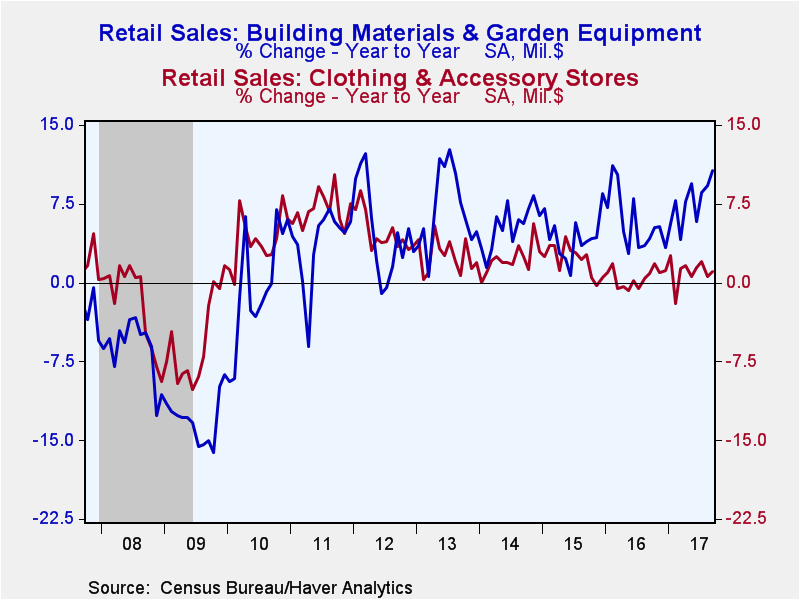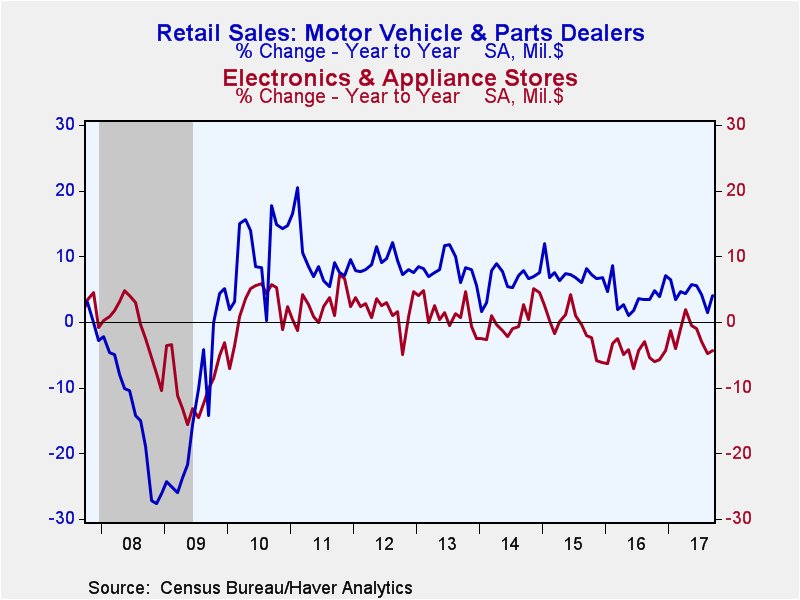 Global| Oct 13 2017
Global| Oct 13 2017U.S. Retail Sales Strengthen
by:Tom Moeller
|in:Economy in Brief
Summary
Total retail sales and spending at restaurants increased 1.6% (4.1% y/y) during September. That followed a 0.1% August dip and a 0.5% July rise, both of which were revised up slightly versus last month's report. A 1.5% increase had [...]
Total retail sales and spending at restaurants increased 1.6% (4.1% y/y) during September. That followed a 0.1% August dip and a 0.5% July rise, both of which were revised up slightly versus last month's report. A 1.5% increase had been expected in the Action Economics Forecast Survey. Leading last month's strength was a 3.6% increase (4.1% y/y) in motor vehicle & parts sales. That compared to a 15.0% rise (4.8% y/y) in unit motor vehicle sales. Retail sales excluding autos improved 1.0% (4.0% y/y) following a 0.5% rise, revised from 0.2%. A 0.8% gain had been expected.
Spending on nonauto discretionary items was mixed last month. Gasoline service station sales jumped 5.8% (10.7% y/y) with higher prices. With rebuilding following Hurricane Harvey, building materials and garden equipment store increased 2.1% (7.7% y/y) following a 0.6% rise. Purchases at apparel stores gained 0.4% (1.5% y/y) after a 0.6% drop. Sales at nonstore retailers increased 0.5% (5.8% y/y) following declines in two of the prior three months. General merchandise store sales improved 0.3% (4.7% y/y) following a 0.4% rise. To the downside were electronics & appliance store sales which fell 1.1% (-5.3% y/y), the fifth consecutive month of decline. Sales at furniture & home furnishings stores were off 0.4% (+1.4% y/y), the second decline in three months. Sporting goods & hobby shop store sales slipped 0.2% (-4.1% y/y), down for the sixth month in the last seven.
In the nondiscretionary sector, food & beverage store sales rose 0.8% (3.4% y/y) following two months of 0.5% increase. Health & personal care store sales declined 0.4% (-0.6% y/y) after a 0.5% rise.
Restaurant sales improved 0.8% (3.3% y/y) following a 0.2% increase.
The retail sales data can be found in Haver's USECON database. The Action Economics forecast expectations are included in the AS1REPNA database.
| Retail Spending (%) | Sep | Aug | Jul | Sep Y/Y | 2016 | 2015 | 2014 |
|---|---|---|---|---|---|---|---|
| Total Retail Sales & Food Services | 1.6 | -0.1 | 0.5 | 4.1 | 3.2 | 2.6 | 4.3 |
| Excluding Autos | 1.0 | 0.5 | 0.5 | 4.0 | 3.0 | 1.4 | 3.8 |
| Non-Auto Less Gasoline | 0.6 | 0.1 | 0.7 | 3.2 | 3.9 | 4.2 | 4.6 |
| Retail Sales | 1.7 | -0.1 | 0.5 | 4.2 | 2.9 | 1.9 | 4.1 |
| Motor Vehicle & Parts | 3.6 | -2.1 | 0.3 | 4.1 | 4.1 | 7.3 | 6.4 |
| Retail Less Autos | 1.1 | 0.5 | 0.6 | 4.2 | 2.5 | 0.4 | 3.4 |
| Gasoline Stations | 5.8 | 4.1 | -0.5 | 10.7 | -5.7 | -17.6 | -2.0 |
| Food Service & Drinking Places Sales | 0.8 | 0.2 | 0.1 | 3.3 | 5.9 | 8.1 | 6.1 |
Tom Moeller
AuthorMore in Author Profile »Prior to joining Haver Analytics in 2000, Mr. Moeller worked as the Economist at Chancellor Capital Management from 1985 to 1999. There, he developed comprehensive economic forecasts and interpreted economic data for equity and fixed income portfolio managers. Also at Chancellor, Mr. Moeller worked as an equity analyst and was responsible for researching and rating companies in the economically sensitive automobile and housing industries for investment in Chancellor’s equity portfolio. Prior to joining Chancellor, Mr. Moeller was an Economist at Citibank from 1979 to 1984. He also analyzed pricing behavior in the metals industry for the Council on Wage and Price Stability in Washington, D.C. In 1999, Mr. Moeller received the award for most accurate forecast from the Forecasters' Club of New York. From 1990 to 1992 he was President of the New York Association for Business Economists. Mr. Moeller earned an M.B.A. in Finance from Fordham University, where he graduated in 1987. He holds a Bachelor of Arts in Economics from George Washington University.










